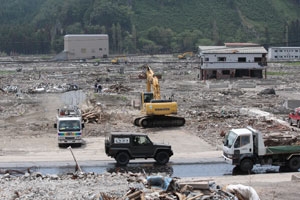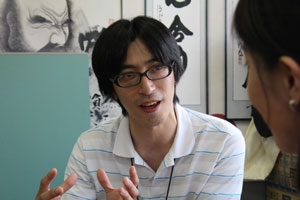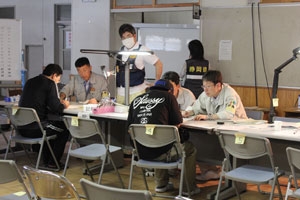Assistance steadily reaching those in need
-Japan Diary by Francis Markus in Otsuchi-
2011/07/14

Almost like a joke in poor taste, the empty shell of a store called the Home amenities centre welcomes us to what remains of the town of Otsuchi, mostly the remains of destroyed buildings and the crushed bodies of cars.
Crossing this obliterated landscape, we come to a small corner of order. Around the prefabricated temporary offices which the local government has set up in a spot cleared amid the destruction is a hive of activity.
(Photo: Speedy disaster debris removal is one of the challenges many affected areas are facing after 4 months since the earthquake and tsunami.)

We’ve come here to talk with Tatsuya Sekiya, a young official in charge of distributing the cash grants that are being given to local residents whose homes have been destroyed.
The Japanese media are asking probing questions about why the cash grants seem to take a long time to distribute. The money used for these grants comes from cash donated directly to the Japanese Red Cross by donors mainly within Japan. The donations made to Japan through the Red Cross Red Crescent around the world are channeled directly into assisting the survivors in temporary shelter and into other recovery and reconstruction projects.
(Photo: Mr.Tatsuya Sekiya, an officer at the social welfare division, a native of Otsuchi, Iwate Prefecture)
“All our staff were needed at the evacuation centres at first,” Tatsuya tells me. Then they had to set up a temporary office themselves on a hill, before building this prefab structure. “Out of 140 government officers, 33 died in the tsunami, but we now have an additional 80 staff members from other parts of the country.”

Out of 4,000 families in Otsuchi who have been able to complete certificates testifying that there houses were damaged or destroyed, 3,000 have applied for cash grants and almost all have received their grants already.
After our interview, I head off towards the shore, making my way through the terrain of debris, where I bump into Dr. Yamaguchi and Mr. Usuzawa, two social activists who are working with the local communities. The older of the two men, Mr. Usuzawa, lived in a house just a few hundred meters from where we stand. He was trapped in his home, as it floated, propelled by the violence of the tsunami. It also caught fire. But thankfully he managed to get out and is here to tell the tale.
(Photo: People stop by at a temporary office to apply for cash grants. Given the shortage of manpower in disaster-stricken areas, many prefectural governments have been sending their staff to support administrative procedures in disaster regions.)

Dr. Yamaguchi is a university assistant professor at the school of social work in Tokyo, and he tells me how the disaster has actually rallied the community spirit of local people, who have organized themselves into a number of self-help groups. I’ve been asking lots of people about the role in this disaster of the local NGOs. But Dr. Yamaguchi gives me the most interesting answer. “The government here is too strong, so the NGOs could not enter the community,” he says. Maybe this disaster will change that. Already the 1995 earthquake in the western city of Kobe helped to reawaken the tradition of volunteerism that previously existed across Japan. This year’s mega-disaster seems certain to amplify that, both with the Red Cross and beyond.
(Photo: Mr. Markus, Communications Delegate, International Federation of Red Cross and Red Crescent Societies, Beijing)
The NGO activists, led by Mr. Usuzawa, have set up a community café at one of the evacuation centres nearby. There, under the baking mid-day sun, Yumi Wakikaido, a social worker from the Japanese Red Cross Society is playing popular tunes on a brass instrument, which to me looks like a tuba, but which I’m told is a euphonium.

When she’s not playing the euphonium for the mainly elderly audience here, Ms.Wakikaido is working with a group of Red Cross carers to help look after old people in a local care home, called Laughing Hills.
Laughing Hills commands a panoramic overview of both the destruction wrought by the tsunami and row upon row of prefabricated temporary housing. It’s a mixed picture, one that will continue to change in the months to come, steadily evolving towards a greater sense of normality for the people of Otsuchi.
My thoughts as I leave this city are on the future; how will people find employment in an area which used to be reliant on the abalone trade with China, but where most of the local fishing boats have been destroyed. Rebuilding the local economy is not going to be a quick process.
(Photo: Ms. Wakikaido, Red Cross social worker, plays the euphonium at a community café in Otsuchi.)















